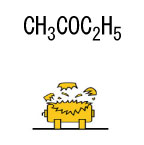| Case Name |
Rupture of a waste liquid container caused due to an incompatible reaction in chemical analysis at a LSI factory |
| Pictograph |

|
| Date |
January 27, 1995 |
| Place |
Yamagata Prefecture, Japan |
| Location |
Semiconductor factory |
| Overview |
In a chemical laboratory at a LSI factory, residual methyl ethyl ketone (MEK), which is an inorganic solvent, was discarded. It was dropped into a waste acid container which adjoined a waste organic solvent container, and they had similar shapes. MEK reacted with nitric acid, the container exploded, and nitric acid spouted out. The cause was human error, but consideration from a human engineering standpoint might have been insufficient. |
| Incident |
In a chemical laboratory at a LSI factory, waste methylethyl ketone (MEK), which is an organic solvent, was put into a container of waste nitric acid, which is an oxidizer, by mistake. An incompatible reaction and subsequent accidents occurred. |
| Processing |
Waste and disposal |
| Substance |
Methyl ethyl ketone, Fig2 |
| Nitric acid, Fig3 |
| Type of Accident |
Rupture |
| Sequence |
Molding removal of resin, etc. was done for a finished product inspection in a chemical laboratory of a LSI factory. A sub-contractor's employee discarded a residual liquid of MEK, which was used for the previous work, and prepared for the subsequent work. Air and orange smoke spouted out. Afterwards, an acid disposal container ruptured, and nitric acid in the container dispersed indoors. Four persons were injured by chemical materials. |
| Cause |
When the sub-contractor's employee threw out the waste MEK, he put it into the waste acid container by mistake. Therefore, an incompatible reaction occurred. The direct cause was human error by the employee. It was well known that contact between MEK and nitric acid generates oxidation and nitration reactions. |
| Countermeasures |
1. A draft chamber with a funnel leading to the waste acid bin was changed to a closed type.
2. Shapes of a waste acid container and a waste organic solvent container were changed so that they could be distinguished easily.
3. The same person consistently should do the same work, which caused the accident.
4. Safety and health education was completed. |
| Knowledge Comment |
Concerning waste materials that have a hazard of contamination, it is required to make a clear distinction in container shapes, container storage space, work methods, etc. In addition, it is necessary to carry out education on the reasons why there are hazards. |
| Background |
1. Two waste bins were placed side by side in a room, and their shape made it difficult to distinguish them. A lack of human engineering considerations caused the accident.
2. The disposal of dangerous substances was left to the subcontractor's employees easily. A management problem is considered.
3. The recognition of contamination danger seemed to be insufficient. There seemed to be inadequate safety education. |
| Reason for Adding to DB |
Example of rupture caused due to insufficient consideration from safety engineering points of view on arrangement of a waste container |
| Scenario |
| Primary Scenario
|
Poor Value Perception, Poor Organizational Culture, No Consideration on Sagety Engineering, Organizational Problems, Poor Management, Poor Operation Management, Carelessness, Insufficient Precaution, Carelessness of Operator, Planning and Design, Poor Planning, Poor Design, Regular Operation, Erroneous Operation, Operation with Insufficient Confirmation, Bad Event, Chemical Phenomenon, Abnormal Reaction, Secondary Damage, External Damage, Rapture/Leakage, Bodily Harm, Injury, 6 person injured
|
|
| Sources |
Japan Industrial Safety and Health Assoc. Details of the accident situation.
Japan Industrial Safety and Health Assoc. Safety and Health information center. Case of labor accident. No.1068. A waste liquid treatment container exploded in a LSI factory chemical laboratory. Burn damage was caused. The Japan Industrial Safety and Health Assoc. home page.
|
| Number of Injuries |
6 |
| Multimedia Files |
Fig2.Chemical formula
|
|
Fig3.Chemical formula
|
| Field |
Chemicals and Plants
|
| Author |
KOBAYASHI, Mitsuo (Office K)
TAMURA, Masamitsu (Center for Risk Management and Safety Sciences, Yokohama National University)
|
|